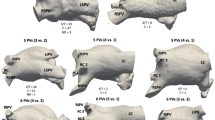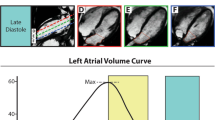Abstract
Atrial fibrillation (AF), the most common human arrhythmia, is a marker of an increased risk of embolic stroke. However, recent studies suggest that AF may not be mechanistically responsible for the stroke events. An alternative explanation for the mechanism of intracardiac thrombosis and stroke in patients with AF is structural remodeling of the left atrium (LA). Nevertheless, a mechanistic link between LA structural remodeling and intracardiac thrombosis is unclear, because there is no clinically feasible methodology to evaluate the complex relationship between these two phenomena in individual patients. Computational fluid dynamics (CFD) is a powerful tool that could potentially link LA structural remodeling and intracardiac thrombosis in individual patients by evaluating the patient-specific LA blood flow characteristics. However, the lack of knowledge of the material and mechanical properties of the heart wall in specific patients makes it challenging to solve the complexity of fluid–structure interaction. In this study, our aim was to develop a clinically feasible methodology to perform personalized blood flow analysis within the heart. We propose an alternative computational approach to perform personalized blood flow analysis by providing the three-dimensional LA endocardial surface motion estimated from patient-specific cardiac CT images. In two patients (case 1 and 2), a four-dimensional displacement vector field was estimated using nonrigid registration. The LA blood outflow across the mitral valve (MV) was calculated from the LV volume, and the flow field within the LA was derived from the incompressible Navier–Stokes equation. The CFD results successfully captured characteristic features of LA blood flow observed clinically by transesophageal echocardiogram. The LA global flow characteristics and vortex structures also agreed well with previous reports. The time course of LAA emptying was similar in both cases, despite the substantial difference in the LA structure and function. We conclude that our CT-based, personalized LA blood flow analysis is a clinically feasible methodology that can be used to improve our understanding of the mechanism of intracardiac thrombosis and stroke in individual patients with LA structural remodeling.








Similar content being viewed by others
Abbreviations
- AF:
-
Atrial fibrillation
- CFD:
-
Computational fluid dynamics
- CT:
-
Computed tomography
- LA:
-
Left atrium
- LAA:
-
Left atrial appendage
- LV:
-
Left ventricle
- MV:
-
Mitral valve
- PV:
-
Pulmonary vein
- TEE:
-
Transesophageal echocardiogram
- 3D:
-
Three-dimensional
- 4D:
-
Four-dimensional
References
Agmon, Y., B. K. Khandheria, F. Gentile, and J. B. Seward. Echocardiographic assessment of the left atrial appendage. J. Am. Coll. Cardiol. 34:1867–1877, 1999. doi:10.1016/S0735-1097(99)00472-6.
Al-Issa, A., Y. Inoue, J. Cammin, Q. Tang, S. Nazarian, H. Calkins, E. K. Fishman, K. Taguchi, and H. Ashikaga. Regional function analysis of left atrial appendage using motion estimation CT and risk of stroke in patients with atrial fibrillation. Eur. Hear. J. Cardiovasc. Imaging jev207, 2015. doi:10.1093/ehjci/jev207.
Benjamin, E. J., R. B. D’Agostino, A. J. Belanger, P. A. Wolf, and D. Levy. Left atrial size and the risk of stroke and death: the Framingham heart study. Circulation 92:835–841, 1995. doi:10.1161/01.CIR.92.4.835.
Blackshear, J. L., and J. A. Odell. Appendage obliteration to reduce stroke in cardiac surgical patients with atrial fibrillation. Ann. Thorac. Surg. 61:755–759, 1996. doi:10.1016/0003-4975(95)00887-X.
Brambatti, M., S. J. Connolly, M. R. Gold, C. A. Morillo, A. Capucci, C. Muto, C. P. Lau, I. C. Van Gelder, S. H. Hohnloser, M. Carlson, E. Fain, J. Nakamya, G. H. Mairesse, M. Halytska, W. Q. Deng, C. W. Israel, and J. S. Healey. Temporal relationship between subclinical atrial fibrillation and embolic events. Circulation 129:2094–2099, 2014. doi:10.1161/CIRCULATIONAHA.113.007825.
Chnafa, C., S. Mendez, and F. Nicoud. Image-based large-eddy simulation in a realistic left heart. Comput. Fluids 94:173–187, 2014. doi:10.1016/j.compfluid.2014.01.030.
Daccarett, M., T. J. Badger, N. Akoum, N. S. Burgon, C. Mahnkopf, G. Vergara, E. Kholmovski, C. J. McGann, D. Parker, J. Brachmann, R. S. MacLeod, and N. F. Marrouche. Association of left atrial fibrosis detected by delayed-enhancement magnetic resonance imaging and the risk of stroke in patients with atrial fibrillation. J. Am. Coll. Cardiol. 57:831, 2011. doi:10.1016/j.jacc.2010.09.049.
Daoud, E. G., T. V. Glotzer, D. G. Wyse, M. D. Ezekowitz, C. Hilker, J. Koehler, P. D. Ziegler, and T. Investigators. Temporal relationship of atrial tachyarrhythmias, cerebrovascular events, and systemic emboli based on stored device data: a subgroup analysis of TRENDS. Heart Rhythm 8:1416–1423, 2011. doi:10.1016/j.hrthm.2011.04.022.
Di Biase, L., P. Santangeli, M. Anselmino, P. Mohanty, I. Salvetti, S. Gili, R. Horton, J. E. Sanchez, R. Bai, S. Mohanty, A. Pump, M. Cereceda Brantes, G. J. Gallinghouse, J. D. Burkhardt, M. Cereceda Brantes, F. Cesarani, M. Scaglione, A. Natale, and F. Gaita. Does the left atrial appendage morphology correlate with the risk of stroke in patients with atrial fibrillation? Results from a multicenter study. J. Am. Coll. Cardiol. 60:531–538, 2012. doi:10.1016/j.jacc.2012.04.032.
Fatema, K., K. R. Bailey, G. W. Petty, I. Meissner, M. Osranek, A. A. Alsaileek, B. K. Khandheria, T. S. Tsang, and J. B. Seward. Increased left atrial volume index: potent biomarker for first-ever ischemic stroke. Mayo Clin. Proc. 83:1107–1115, 2008. doi:10.4065/83.10.1107.
Fyrenius, A., L. Wigström, T. Ebbers, M. Karlsson, J. Engvall, and A. F. Bolger. Three dimensional flow in the human left atrium. Heart 86:448–455, 2001. doi:10.1136/heart.86.4.448.
Goubergrits, L., U. Kertzscher, K. Affeld, C. Petz, D. Stalling, and H. C. Hege. Numerical dye washout method as a tool for characterizing the heart valve flow: study of three standard mechanical heart valves. ASAIO J. 54:50–57, 2008. doi:10.1097/MAT.0b013e31815c5e38.
Healey, J. S., S. J. Connolly, M. R. Gold, C. W. Israel, I. C. Van Gelder, A. Capucci, C. P. Lau, E. Fain, S. Yang, C. Bailleul, C. A. Morillo, M. Carlson, E. Themeles, E. S. Kaufman, and S. H. Hohnloser. Subclinical atrial fibrillation and the risk of stroke. N. Engl. J. Med. 366:120–129, 2012. doi:10.1056/NEJMoa1105575.
Inoue, Y. Y., A. Alissa, I. M. Khurram, K. Fukumoto, M. Habibi, B. A. Venkatesh, S. L. Zimmerman, S. Nazarian, R. D. Berger, H. Calkins, J. A. Lima, and H. Ashikaga. Quantitative tissue-tracking cardiac magnetic resonance (CMR) of left atrial deformation and the risk of stroke in patients with atrial fibrillation. J. Am. Heart Assoc. 4:e001844–e001844, 2015. doi:10.1161/JAHA.115.001844.
Khurram, I. M., J. Dewire, M. Mager, F. Maqbool, S. L. Zimmerman, V. Zipunnikov, R. Beinart, J. E. Marine, D. D. Spragg, R. D. Berger, H. Ashikaga, S. Nazarian, and H. Calkins. Relationship between left atrial appendage morphology and stroke in patients with atrial fibrillation. Heart Rhythm 10:1843–1849, 2013. doi:10.1016/j.hrthm.2013.09.065.
Kim, T., A. Y. Cheer, and H. A. Dwyer. A simulated dye method for flow visualization with a computational model for blood flow. J. Biomech. 37:1125–1136, 2004. doi:10.1016/j.jbiomech.2003.12.028.
Kimura, T., S. Takatsuki, K. Inagawa, Y. Katsumata, T. Nishiyama, N. Nishiyama, K. Fukumoto, Y. Aizawa, Y. Tanimoto, K. Tanimoto, M. Jinzaki, and K. Fukuda. Anatomical characteristics of the left atrial appendage in cardiogenic stroke with low CHADS2 scores. Heart Rhythm 10:921–925, 2013. doi:10.1016/j.hrthm.2013.01.036.
Kizer, J. R., J. N. Bella, V. Palmieri, J. E. Liu, L. G. Best, E. T. Lee, M. J. Roman, and R. B. Devereux. Left atrial diameter as an independent predictor of first clinical cardiovascular events in middle-aged and elderly adults: the Strong Heart Study (SHS). Am. Heart J. 151:412–418, 2006. doi:10.1016/j.ahj.2005.04.031.
Koizumi, R., K. Funamoto, T. Hayase, Y. Kanke, M. Shibata, Y. Shiraishi, and T. Yambe. Numerical analysis of hemodynamic changes in the left atrium due to atrial fibrillation. J. Biomech. 48:472–478, 2015. doi:10.1016/j.jbiomech.2014.12.025.
Ku, D. N. Blood flow in arteries. Annu. Rev. Fluid Mech. 29:399–434, 1997. doi:10.1146/annurev.fluid.29.1.399.
Miller, J. M., C. E. Rochitte, M. Dewey, A. Arbab-Zadeh, H. Niinuma, I. Gottlieb, N. Paul, M. E. Clouse, E. P. Shapiro, J. Hoe, A. C. Lardo, D. E. Bush, A. de Roos, C. Cox, J. Brinker, and J. A. C. Lima. Diagnostic performance of coronary angiography by 64-row CT. N. Engl. J. Med. 359:2324–2336, 2008. doi:10.1056/NEJMoa0806576.
Morales, H., I. Larrabide, A. Geers, L. San Roman, J. Blasco, J. Macho, and A. Frangi. A virtual coiling technique for image-based aneurysm models by dynamic path planning. IEEE Trans. Med. Imaging 1–11, 2012. doi:10.1109/TMI.2012.2219626.
Ozer, N., L. Tokgozoglu, K. Ovunc, G. Kabakci, S. Aksoyek, K. Aytemir, and S. Kes. Left atrial appendage function in patients with cardioembolic stroke in sinus rhythm and atrial fibrillation. J. Am. Soc. Echocardiogr. 13:661–665, 2000. doi:10.1067/mje.2000.105629.
Piccini, J. P., and J. P. Daubert. Atrial fibrillation and stroke: it’s not necessarily all about the rhythm. Heart Rhythm 8:1424–1425, 2011. doi:10.1016/j.hrthm.2011.05.005.
Pourmorteza, A., K. H. Schuleri, D. A. Herzka, A. C. Lardo, and E. R. McVeigh. A new method for cardiac computed tomography regional function assessment: Stretch quantifier for endocardial engraved zones (SQUEEZ). Circ. cardiovasc. Imaging 5:243–250, 2012. doi:10.1161/CIRCIMAGING.111.970061.
Russo, C., Z. Jin, R. Liu, S. Iwata, A. Tugcu, M. Yoshita, S. Homma, M. S. V. Elkind, T. Rundek, C. Decarli, B. Wright, R. L. Sacco, and M. R. Di Tullio. LA volumes and reservoir function are associated with subclinical cerebrovascular disease: The CABL (Cardiovascular Abnormalities and Brain Lesions) study. JACC. Cardiovasc. Imaging 6:313–324, 2013. doi:10.1016/j.jcmg.2012.10.019.
Seo, J. H., and R. Mittal. Effect of diastolic flow patterns on the function of the left ventricle. Phys. Fluids 25:110801, 2013. doi:10.1063/1.4819067.
Seo, J. H., V. Vedula, T. Abraham, A. C. Lardo, F. Dawoud, H. Luo, and R. Mittal. Effect of the mitral valve on diastolic flow patterns. Phys. Fluids 26:121901, 2014. doi:10.1063/1.4904094.
Smiseth, O. A., C. R. Thompson, K. Lohavanichbutr, H. Ling, J. G. Abel, R. T. Miyagishima, S. V. Lichtenstein, and J. Bowering. The pulmonary venous systolic flow pulse–its origin and relationship to left atrial pressure. J. Am. Coll. Cardiol. 34:802–809, 1999. doi:10.1016/S0735-1097(99)00300-9.
Tsang, T. S. M., W. P. Abhayaratna, M. E. Barnes, Y. Miyasaka, B. J. Gersh, K. R. Bailey, S. S. Cha, and J. B. Seward. Prediction of cardiovascular outcomes with left atrial size: Is volume superior to area or diameter? J. Am. Coll. Cardiol. 47:1018–1023, 2006. doi:10.1016/j.jacc.2005.08.077.
Vedula, V., R. George, L. Younes, and R. Mittal. Hemodynamics in the left atrium and its effect on ventricular flow patterns. J. Biomech. Eng. 2015. doi:10.1115/1.4031487.
Wolf, P. A., R. D. Abbott, and W. B. Kannel. Atrial fibrillation as an independent risk factor for stroke: the Framingham study. Stroke 22:983–988, 1991. doi:10.1161/01.STR.22.8.983.
Wong, J. M., C. C. Welles, F. Azarbal, M. A. Whooley, N. B. Schiller, and M. P. Turakhia. Relation of left atrial dysfunction to ischemic stroke in patients with coronary heart disease (from the Heart and Soul Study). Am. J. Cardiol. 113:1679–1684, 2014. doi:10.1016/j.amjcard.2014.02.021.
Zhang, L., and M. Gay. Characterizing left atrial appendage functions in sinus rhythm and atrial fibrillation using computational models. J. Biomech. 41:2515–2523, 2008. doi:10.1016/j.jbiomech.2008.05.012.
Acknowledgments
The authors thank Satoshi Ii for valuable input as to the CFD methodology. The authors also thank Yuko Inoue and Susumu Tao for clinical input. This work was supported by research grants from the Japan Society for the Promotion of Science (JSPS) (Research Fellowship for Young Scientist A2616220, to Otani), Magic That Matters Fund for Cardiovascular Research (to Ashikaga) and Zegar Family Foundation (to Ashikaga).
Conflict of interest
None.
Author information
Authors and Affiliations
Corresponding author
Additional information
Associate Editor Peter E. McHugh oversaw the review of this article.
Electronic supplementary material
Below is the link to the electronic supplementary material.
Supplementary material 2 (MP4 2514 kb)
Supplementary material 3 (MP4 2486 kb)
Supplementary material 4 (MP4 1868 kb)
Supplementary material 5 (MP4 1686 kb)
Rights and permissions
About this article
Cite this article
Otani, T., Al-Issa, A., Pourmorteza, A. et al. A Computational Framework for Personalized Blood Flow Analysis in the Human Left Atrium. Ann Biomed Eng 44, 3284–3294 (2016). https://doi.org/10.1007/s10439-016-1590-x
Received:
Accepted:
Published:
Issue Date:
DOI: https://doi.org/10.1007/s10439-016-1590-x




